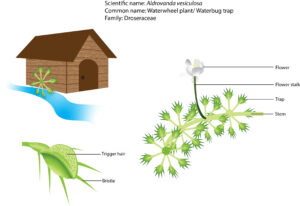
Aldrovanda vesiculosa, the waterwheel that is not powered by water
Utricularia is a semi-aquatic carnivorous plant that can grow in the terrestrial or aquatic environment. There is another exotic aquatic carnivorous plant, Aldrovanda vesiculosa. It is first observed in India in the sixteenth century. It is a true aquatic carnivore in the family of Droseraceae that is believed to be a direct relative of the Dionaea muscipula, the Venus flytrap due to its snap trap that is similar to that of Venus flytrap. They are […]
Read More
Succulents, the most “suc”-cessful plants
Succulent, the most “suc”-cessful survivor that can be found in arid areas such as desert when nothing is found. Then how about cactus, the most famous desert plant? Well, succulent commonly named as xerophytes, xeros means dry, because of their adaptability to live in a dry environment. Cactus (plural cacti) is one of the widely known examples of succulents. Almost all cacti are stem succulents. Overall, succulents are briefly referring to the rosette-plants that have […]
Read More
Cephalotus – the smallest pitcher plant
Background The smallest carnivorous pitcher is the west Australian pitcher plant, Cephalotus follicularis. It is one of the most desired carnivorous plants in the collection as well as cultivation. Cephalotus is a thumb-size pitcher of compact growth up to two inches long with colorful and bristly pitchers that are seemingly yawning for a bite to eat. It is a monotypic genus under the family of Cephalotaceae that is commonly referred to as the Albany pitcher […]
Read More
Phytochemicals – a colorful rainbow that is edible
Natural light separates into seven different colors through a prism, which is red, orange, yellow, green, blue, indigo, and purple. Luckily these are the colors you can find on your dinner table, a full spectrum of the rainbow that is edible. Colorful food is a visual delight, the diversified colors are not just an enhancement of the appearance of food but also beneficial to our health in many ways. In this article, the colors are […]
Read More
Utricularia – the smallest but fastest carnivorous plant
There is the various size of the carnivorous plant, but there is a carnivorous plant that does not look like one due to its tiny size and hidden preying mechanism. This species of Utricularia is under the family of Lentibulariaceae and native to North America. Commonly known as bladderworts, it was virtually unknown except to specialists such as aquarium hobbyists due to several reasons. They are always found in very wet areas or in the […]
Read More
Pitcher plants – the “reed pipe” in nature
Background Pitcher plants are scattered around the world. Apart from Nepenthes and Darlingtonia, there are two more pitchers with different genus that are generally known as the American pitcher plants. Namely, Sarracenia and Heliamphora that both under the family of Sarraceniaceae. They are referred to as passive carnivores in which they use a passive preying mechanism that solely relies on the nectar and color or pigmentation of the modified leaves without any structural movements of […]
Read MoreHow do plants achieve their form and stature
View, browse, and/or download material for educational and temporary copying purposes only.
Read More
Darlingtonia, the cobra in carnivorous plants
Background Darlingtonia is commonly known as cobra lily due to its startling and special morphological structures. It is dicots, asterids, and found under the family of Sarraceniaceae. Obviously, Darlingtonia is very closely related to Sarracenia which is an allied genus known as trumpet pitchers that is indigenous to the eastern coast of the USA. It is so special with its bulbous green or red heads with a twisted colorful tongue that looks exactly like a cobra. […]
Read More